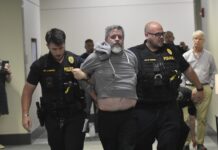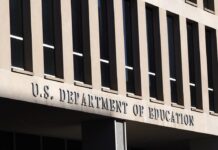
University System of Georgia Chancellor Steve Wrigley Tuesday defended his decision to bring students back to campus for in-person learning and pledged to continue to push for students and instructors to get together in classrooms.
“We believe strongly in on-campus instruction, the richness it adds to education and the total student experience,” Wrigley told members of the system’s Board of Regents. “We will therefore stay the course, with your support.”
The start of the fall semester has been tainted by clusters of COVID-19 outbreaks in universities and college towns. The University of Georgia has reported more than 2,500 cases as of Sept. 6, and Georgia Southern University has experienced more than 1,000 through last week.
The Athens metropolitan area, with 61.5 cases per 100,000 people, is the metro area with the fourth-highest number of new cases relative to population in the last two weeks, according to data from the New York Times. Statesboro, home of Georgia Southern, is ranked No. 7.
But increases in COVID-19 diagnoses are proving to be temporary, and they stem mostly from off-campus gatherings, Wrigley said.
“A few campuses have seen large increases in positive COVID-19 tests, largely among students, and that appears to be a result of off-campus activities, something institutions across the country have also experienced,” he said. “Most of the first USG campuses experiencing these initial increases in cases have recently seen significant declines as extra attention was given to reducing off campus risks. Students who have tested positive mostly have had mild or no symptoms and have returned to class after getting well.”
Wrigley urged students to continue social distancing, wearing masks and washing their hands to avoid a new case spike.
“All of these measures will reduce the transmission of the disease if everyone adheres to them,” he said. “While we have seen successes with reducing case counts after initial increases, we must remain vigilant. It is a long semester, and COVID-19 thrives on congregations and carelessness.”
Student reaction
Wrigley’s plan to forge ahead with classroom instruction this fall is a relief for students like Zach Morin, a freshman at the University of Georgia who wants to keep studying there.
“It’s definitely not something that I’m ecstatic about, this is a tough situation for everyone, but this is better than nothing,” he said. “We have seen what it’s like for everything to be shut down and have nothing when high school shut down, so we do know what nothing is, and it’s better than nothing.”
Morin goes to an in-person class once or twice a week, and he does the rest of his studies online. It’s not the college experience he was hoping for, but he’s been getting to know the people in his dorms and is staying positive.
“I’m glad we have this,” he said. “I’m glad we have something. It can always be more, and I hope it goes in that direction, but overall, I think this is a lot better than being sent home.”
Others on campus are not happy with Wrigley’s statement.
Junior Arianna Mbunwe is a member of a group of students organizing campus demonstrations to protest the university’s COVID response Thursday through Saturday.
“The university is not responding to any students’ concerns or student workers’ concerns, so we figured we’d take it into our own hands and demand some type of response or meeting or something so people can get some kind of clarity about what the university is doing,” she said.
Mbunwe said she wants to see more testing facilities, better enforcement of COVID-19 safety rules and testing numbers released daily instead of weekly, as they are now.
Mbunwe has been tweeting out photos and text messages from students, faculty and staff with concerns about the school’s handling of the pandemic, including photos of mold on sanitation wipe stations and professors who say they have been told not to change the location of their classes or alert students if a classmate is diagnosed with COVID-19.
“It’s just disheartening to read a lot of the things, all of the things that people are going through, when the university is supposed to be caring about students, and every DM that I get is a direct contradiction of that,” she said. “I have yet to get a positive DM about the university, and it’s not like I’m saying it all has to be bad, I just said simply share your experiences, but everything has been bad.”
Professors respond
An online-only semester could have meant big losses for the university system – over $479 million in student fees, housing and dining revenue, according to the Atlanta Journal-Constitution.
Georgia State University had plans to open its dorms at 75% capacity at the start of the semester, which would have lost over $3 million for Corvias Property Management, the private company that operates dormitories there and eight other Georgia colleges.
In a May letter to the Board of Regents, Corvias called for the board to avoid a reduction in occupancy, but lower-than-normal dorm demand rendered the discussion moot.
The push to protect in-person classes is leading some who are affected to allege that the university system is more concerned about its financial interests over the needs of students and workers.
“It is like the money has ‘talked them into’ thinking they can mitigate/control the virus,” said Matthew Boedy, president of the Georgia Conference of the American Association of University Professors and professor of rhetoric and composition at the University of North Georgia. “Yes, (there would be) huge losses without these on-campus fees. Huge losses if we had no dorm contracts. And those losses would definitely mean cuts if not for any other source — federal or state — happening. But the USG constantly goes back to the claim that students want this on-campus experience. Other than enrollment, with mind you 50% or so fully online and the rest a combo of online and in-person, what evidence is there?”
In recent weeks a fraction of the usual number of students are walking the campuses of universities several weeks into fall semester, including at Georgia State and Georgia Tech.
The University System of Georgia did not respond to requests for comment.
Boedy has called on Wrigley to move the system online.
“Sending students home at this point in the semester has risks, but we can alleviate those with a massive testing effort,” Boedy said in a Sept. 11 letter to Wrigley. “Consider a hiatus of in-person classes combined with a mandate to test all students and employees who are on campus. This can show us who we need to isolate and who we can send back to their communities.
“We thank you for your efforts so far. But the pandemic is not going away. It won’t until a vaccine is widely available. This means this semester and the next the USG faces the risk of further harming all those connected to its campuses.”
Wrigley has not responded to the letter, or to a petition from Georgia Southern’s chapter of the American Association of University Professors with nearly 700 signatures calling for classes to move online.
Boedy said he disagrees with Wrigley’s assertion that initial case numbers are dropping.
“You can’t say that with a straight face because of the lack of surveillance testing beyond a few schools with minimum numbers,” he said. “A fall in reports is not a fall in cases or a slow of the spread. If Chancellor Wrigley is basing his ‘stay the course’ plan on reported cases and not broad surveillance testing, that tells me what I already know: the USG never had any intention of letting the science dictate.”
Some of the university system’s 26 schools are performing surveillance testing, but many are not, and each institution reports its own data independently. That makes it harder to track the infection’s spread for public health professionals like Georgia State University public health professor Dr. Harry J. Heiman.
The University System of Georgia should provide supplies for all of its institutions to perform surveillance testing of students, faculty and staff and publish the results on its website, Heiman said.
“Part of the challenge for me and others is that because there hasn’t been a coordinated approach to surveillance of students in a systematic way, testing students who are not symptomatic, and offering access to not only students, but faculty and staff, if they’re symptomatic or just desire to be tested,” he said. “It’s very challenging to compare institution to institution.”
Heiman also took issue with Wrigley’s assertion that the virus is spreading at off-campus events.
“I think that to suggest that the lack of significant cases among faculty and staff is due to off-campus activities is misinterpreting numbers,” Heiman said. “I mean, they’re doing surveillance of students. They’re not doing surveillance of faculty and staff, to start with. And number two, if you look at the numbers I’ve seen, we’re beginning to see trends in the wrong direction.”







